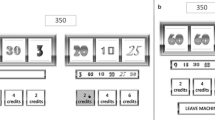Abstract
We evaluated an intervention based on a digital slot machine accelerator and whether the accelerator would decrease persistence in play on a subsequent gambling analog task. Ninety college students were randomly assigned to one of three interventions: the digital slot machine accelerator; an educational handout describing probabilities and concepts related to slot machine gambling; a control handout unrelated to gambling. Participants then played a realistic three-reel 5¢ slot machine pre-loaded with 30 credits. Participants could stop playing on any trial and could keep winnings beyond the initial 30 credits. We found that exposure to either the accelerator or educational handout decreased participants’ judgments of the probability of winning. However, only participants in the accelerator condition, not those in the educational handout condition, played significantly fewer trials on the slot machine than controls. Thus, intervention and prevention efforts may be strengthened by advanced gambling simulation that experientially demonstrate the negative long-term outcomes of gambling.


Similar content being viewed by others
References
Ariyabuddhiphongs, V. (2013). Problem gambling prevention: before, during, and after measures. International Journal of Mental Health and Addiction, 11(5), 568–582.
Baker, J. (2012). AllJ Slots (2.287) [Computer software]. Retrieved from http://www.alljsoftware.com/
Bednarz, J., Delfabbro, P., & King, D. (2013). Practice makes poorer: practice gambling modes and their effects on real-play in simulated roulette. International Journal of Mental Health and Addiction, 11(3), 381–395.
Catania, A. C., Shimoff, E., & Matthews, B. A. (1989). An experimental analysis of rule- governed behavior. In S. C. Hayes (Ed.), Rule-governed behavior (pp. 119–150). Springer US.
Doiron, J. P., & Nicki, R. M. (2007). Prevention of pathological gambling: a randomized controlled trial. Cognitive Behaviour Therapy, 36(2), 74–84.
Gainsbury, S., & Blaszczynski, A. (2011). The appropriateness of using laboratories and student participants in gambling research. Journal of Gambling Studies, 27(1), 83–97.
Ladouceur, R. (1996). The prevalence of pathological gambling in Canada. Journal of Gambling Studies, 12(2), 129–142.
Ladouceur, R., Sylvain, C., Boutin, C., Lachance, S., Doucet, C., Leblond, J., & Jacques, C. (2001). Cognitive treatment of pathological gambling. The Journal of Nervous and Mental Disease, 189(11), 774--780.
Ladouceur, R., Goulet, A., & Vitaro, F. (2013). Prevention programmes for youth gambling: a review of the empirical evidence. International Gambling Studies, 13(2), 141–159.
Lesieur, H. R., & Blume, S. B. (1987). The south oaks gambling screen (SOGS): a new instrument for the identification of pathological gamblers. American Journal of Psychiatry, 144(9), 1184–1188.
Monaghan, S., Blaszczynski, A., & Nower, L. (2009). Consequences of winning: the role of gambling outcomes in the development of irrational beliefs. Behavioural and Cognitive Psychotherapy, 37(01), 49–59.
Nowak, D. E., & Aloe, A. M. (2014). The prevalence of pathological gambling among college students: a meta-analytic synthesis, 2005–2013. Journal of Gambling Studies, 30(4), 819–843.
Parke, J., & Griffiths, M. (2006). The psychology of the fruit machine: the role of structural characteristics (revisited). International Journal of Mental Health and Addiction, 4(2), 151–179.
Rachlin, H. (2007). In what sense are addicts irrational? Drug and Alcohol Dependence, 90, S92–S99.
Reese, H. W. (1989). Rules and rule-governance: cognitive and behavioristic views. In S. C. Hayes (Ed.), Rule-governed behavior: cognitions, contingencies, and instructional control (pp. 3–84). New York, NY: Springer.
Shaffer, H. J., & Hall, M. N. (2001). Updating and refining prevalence estimates of disordered gambling behaviour in the United States and Canada. Revue Canadienne de Santé Publique, 92(3), 168–172.
Sharpe, L. (2002). A reformulated cognitive–behavioral model of problem gambling: a biopsychosocial perspective. Clinical Psychology Review, 22(1), 1–25.
Steenbergh, T. A., Meyers, A. W., May, R. K., & Whelan, J. P. (2002). Development and validation of the gamblers’ beliefs questionnaire. Psychology of Addictive Behaviors, 16(2), 143–149.
Vitali, A. A., Pillan, M., & Riva, P. R. (2014). Beyond Gambling Temptations: An Experimental Design Project to Detoxify Players from Irresistible Illusions of Gambling. In Games and Learning Alliance (pp. 290–303). Springer International Publishing.
Volberg, R. A., & Steadman, H. J. (1988). Refining prevalence estimates of pathological gambling. The American Journal of Psychiatry, 145(4), 502.
Williams, R. J., & Connolly, D. (2006). Does learning about the mathematics of gambling change gambling behavior? Psychology of Addictive Behaviors, 20(1), 62.
Williams, R. J., Wood, R. T., & Currie, S. R. (2010). Stacked deck: an effective, school- based program for the prevention of problem gambling. The Journal of Primary Prevention, 31(3), 109–125.
Williams, R. J., Volberg, R. A., & Stevens, R. M. (2012a). The population prevalence of problem gambling: methodological influences, standardized rates, jurisdictional differences, and worldwide trends. Ontario Problem Gambling Research Centre.
Williams, R. J., West, B. L., & Simpson, R. I. (2012b). Prevention of problem gambling: A comprehensive review of the evidence and identified best practices. Ontario Problem Gambling Research Centre and the Ontario Ministry of Health and Long Term Care.
Wohl, M. J., Santesso, D. L., & Harrigan, K. (2013). Reducing erroneous cognition and the frequency of exceeding limits among slots players: a short (3-minute) educational animation facilitates responsible gambling. International Journal of Mental Health and Addiction, 11(4), 409–423.
Author information
Authors and Affiliations
Corresponding author
Rights and permissions
About this article
Cite this article
Broussard, J., Wulfert, E. Can an Accelerated Gambling Simulation Reduce Persistence on a Gambling Task?. Int J Ment Health Addiction 15, 143–153 (2017). https://doi.org/10.1007/s11469-015-9620-8
Published:
Issue Date:
DOI: https://doi.org/10.1007/s11469-015-9620-8



